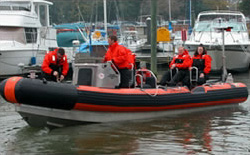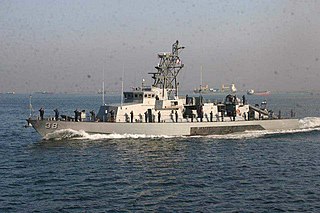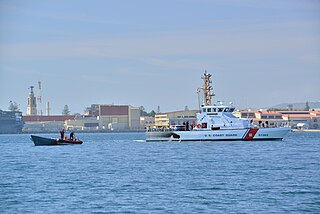
A dinghy is a type of small boat, often carried or towed by a larger vessel for use as a tender. Utility dinghies are usually rowboats or have an outboard motor. Some are rigged for sailing but they differ from sailing dinghies, which are designed first and foremost for sailing. A dinghy's main use is for transfers from larger boats, especially when the larger boat cannot dock at a suitably-sized port or marina.

The Zodiac Milpro Futura Commando 470 or in short FC470 Combat Rubber Raiding Craft (CRRC), also known as the "Combat Rubber Reconnaissance Craft," is a specially fabricated rubber inflatable boat often used by the U.S. Navy, U.S. Marine Corps, the U.S. Army, and others. The CRRC is typically called "Zodiac," referring to the boat's manufacturer, Zodiac Milpro.

A slipway, also known as boat ramp or launch or boat deployer, is a ramp on the shore by which ships or boats can be moved to and from the water. They are used for building and repairing ships and boats, and for launching and retrieving small boats on trailers towed by automobiles and flying boats on their undercarriage.

A dive boat is a boat that recreational divers or professional scuba divers use to reach a dive site which they could not conveniently reach by swimming from the shore. Dive boats may be propelled by wind or muscle power, but are usually powered by internal combustion engines. Some features, like convenient access from the water, are common to all dive boats, while others depend on the specific application or region where they are used. The vessel may be extensively modified to make it fit for purpose, or may be used without much adaptation if it is already usable.

The Marine Protector-class patrol boat is a type of coastal patrol boat of the United States Coast Guard. The 87-foot-long (27 m) vessels are based on the Stan 2600 design by Damen Group and were built by Bollinger Shipyards of Lockport, Louisiana. Each boat is named after sea creatures that fly or swim.

The United States Coast Guard (USCG) Short Range Prosecutor is a 7-meter, high speed launch designed to be launched from cutters, at speed, from a stern launching ramp. The Short Range Prosecutor is a rigid-hull inflatable, powered by water-jets, for intercepting and boarding suspect vessels. It mounts a radar and special shock-proof seats, and can travel at 30 knots.

Wide West was a steamboat that served in the Pacific Northwest of the United States. It had a reputation as a luxury boat of its days.

The Point-class cutter was a class of 82-foot patrol vessels designed to replace the United States Coast Guard's aging 83-foot wooden hull patrol boat being used at the time. The design utilized a mild steel hull and an aluminum superstructure. The Coast Guard Yard discontinued building the 95-foot Cape-class cutter to have the capacity to produce the 82-foot Point-class patrol boat in 1960. They served as patrol vessels used in law enforcement and search and rescue along the coasts of the United States and the Caribbean. They also served in Vietnam during the Vietnam War. They were replaced by the 87-foot Marine Protector-class coastal patrol boats beginning in the late 1990s.

BRP General Mariano Alvarez (PS-38) is the lead ship of its class of three coastal patrol ships currently in service with the Philippine Navy. She was the lead ship of the US Navy's Cyclone-class patrol ship prior to being transferred to the Philippine Navy.

USCGC Fir (WLB-213) is a Juniper-class cutter of the United States Coast Guard. USCGC Fir is under the Operational Control (OPCON) of the Commander of the Thirteenth Coast Guard District and is homeported in Astoria, Oregon. Fir's primary area of responsibility is the coastal waters, river bars and high seas of the Washingtonian and Oregonian coasts. USCGC Fir conducts heavy lift aids to navigation operations, law enforcement and other missions as directed.

The Cutter Boat – Over the Horizon (CB-OTH), is a cutter-deployed rigid-hulled inflatable boat in service with the United States Coast Guard. It is designed to pursue and interdict fast, non-compliant vessels. As of March 2018, 78 boats have been delivered, and deployed on a variety of cutters, including the Maritime Security Cutters, Hamilton-class High Endurance Cutters, and Famous and Reliance-class Medium Endurance Cutters, and the Sentinel-class cutters. Eventually, at least 101 boats will be deployed.

The Spearhead-class expeditionary fast transport (EPF) is a United States Navy–led shipbuilding program to provide a high-speed, shallow draft vessel intended for rapid intra-theater transport of medium-sized cargo payloads. The EPFs can reach speeds of 35–45 knots, and allow the rapid transit and deployment of conventional or special forces, equipment and supplies.

The San Juan-class patrol vessel consists of four vessels built by the Australian shipbuilding company Tenix for the Philippine Coast Guard. They were commissioned from 2000 to 2003. Their hull number prefix "SARV" means they are classified by the coast guard as "search and rescue vessels". They specialize in and are designed for search and rescue and other maritime emergencies.

USCGC John McCormick (WPC-1121) is the United States Coast Guard's 21st Sentinel-class cutter, and the first to be stationed in Alaska, where she is homeported at Coast Guard Base Ketchikan.

USCGC Sea Otter (WPB-87362) is the 61st cutter in the United States Coast Guard's successful Marine Protector class.

The United States is building 13 small patrol vessels, based on the Damen Stan 2606 patrol vessel design, for small Caribbean nations, to be known as the Defiant class. The United States Navy, which will play an oversight role in the ship's construction, also calls the design Near Coastal Patrol Vessels. The $54 million contract was awarded to Metal Shark Boats of Louisiana.

The USCGC Cochito (WPB-87329) is an 87-foot (27 m) Marine Protector cutter operated by the United States Coast Guard.

RSIPV Gizo (05) is a Guardian-class patrol boat in service with the Royal Solomon Islands Police Force Maritime Department. She was the fifth boat of her class to be completed. Australian officials officially handed her over to representatives of the Solomon Islands on 8 November 2019, at the Austal shipyard in Henderson, Western Australia.

USCGC Terrapin (WPB-87366) is a United States Coast Guard ship of the Marine Protector class. She is assigned to Coast Guard District 13 and is home-ported at Bellingham, Washington. Her main areas of responsibility are the San Juan Islands, the Strait of Juan de Fuca, and Puget Sound. Her missions include search and rescue, law enforcement, and homeland security.

The Confiance class or Patrouilleurs Antilles Guyane (PAG), previously called "Patrouilleurs légers guyanais" (PLG, "Light Guyane patrol vessel") until January 2019 is a type of high sea patrol vessel developed and built by Socarenam based upon plans by Mauric. They are in service with the French Navy.





















